Blog Archives
Brush-turkey mound: I think she likes it!
Here’s a male Australian Brush-turkey showing a lady around his mound. The male is the one in front, with the bright yellow pouch dangling around his neck:

This particular Brush-turkey has been perfecting his mound for weeks. It’s good to see he’s getting some interest. Both birds are looking smart in their spring plumage.
This second picture is for scale, to show the size of the mound relative to some tree trunks and a fire gate:

The male builds and maintains the mound and invites a female to it. If she’s impressed, the female consents to mate with him and then lays her eggs in the mound. The eggs incubate and hatch without help, and the chicks emerge ready to take on the world.
Common name: Australian Brush-turkey
Scientific name: Alectura lathami
Approximate length: 60-70 cm
Date spotted: 23 September 2025 (spring)
Location: Manly Dam, New South Wales, Australia: 33°46’55.5″S 151°15’09.6″E
Longest nest-sitting ever: Black Swans abandon nest after 8 months (part 2 of story)
Over the past 8 months, two Black Swans have been diligently tending a nest in Manly Dam Park, in Sydney’s Northern Beaches. In the early days (August 2024), spring was in the air. Nature was blooming and the swans were devoted and diligent. As spring turned to summer, the heat bore down. Cicadas shrieked, reeds grew up and died down again. Still, the pair tended the nest, rebuilding regularly, looking after each other, and clearing the water around their nest. (Story of two nesting Black Swans: Part 1)
Yesterday (9 April 2025), for the first time, the nest was empty when I walked past. The nest is the large circle of brown reeds lying horizontal behind the green reeds:

A hundred metres away, one of the swans was drifting on the water, hooting quietly and persistently:
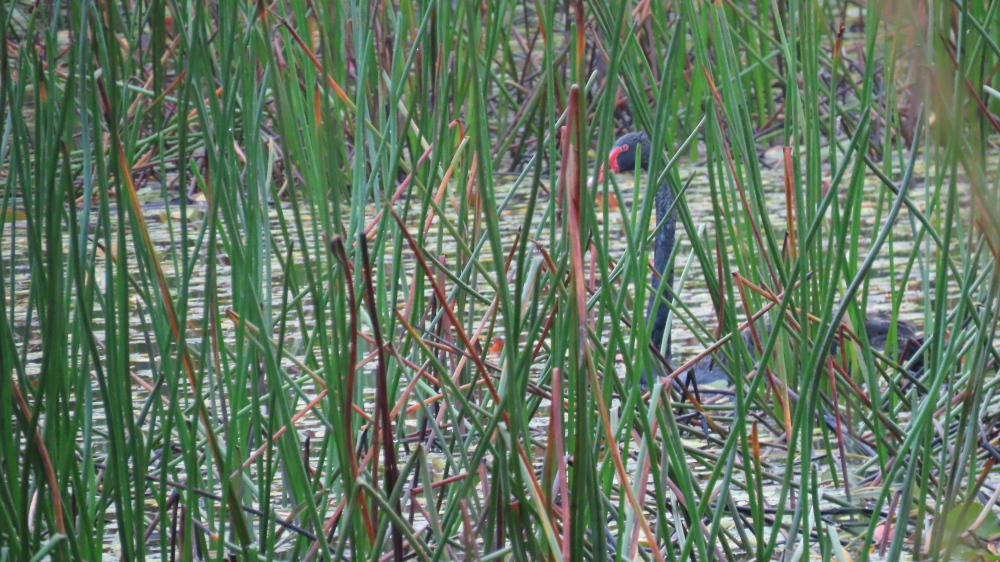
Once or twice I heard the other swan replying from deep in the reeds, but I didn’t see it.
At my previous visit a week ago, the swans had moved their nest to a slightly different location, just ten metres or so away from the original location. I wondered if this meant that at last, there was hope for an egg or two. Who knows, perhaps the pair will proudly emerge with a train of cygnets to show. Alas, though, I doubt that there were ever any eggs in the nest. From a discussion on Reddit, it seems that the most likely explanation is that the swans are two males, practising nest-building and nest-sitting in the absence of a female to lay an egg.
Here’s a photo from October 2024, showing both swans at the nest:

Here’s one of the swans in early February 2025, off shift for a moment while its partner sits on the nest:
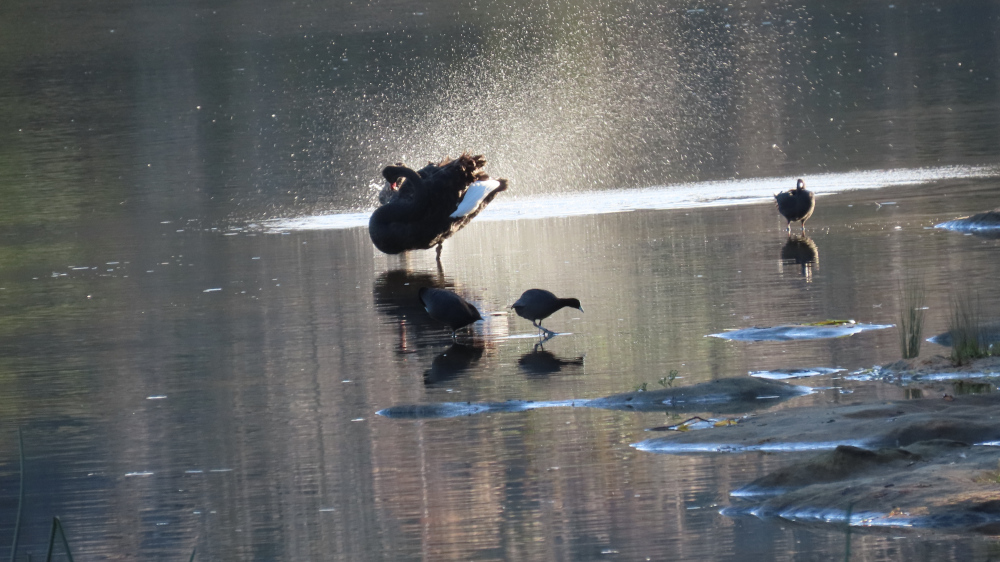
This is the tranquil site of the nest, now empty, but ready perhaps for a new attempt come spring:
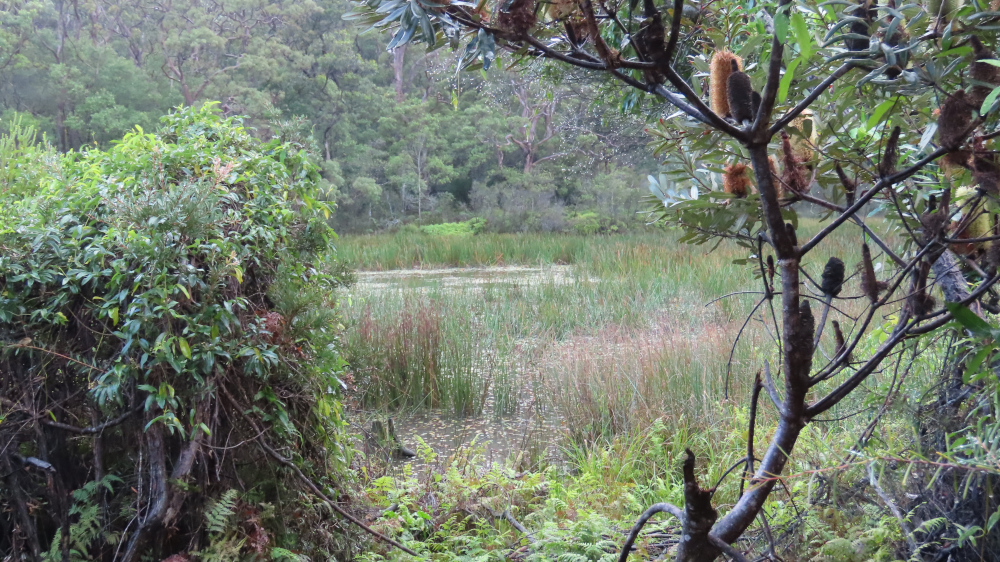
Common name: Black Swan
Scientific name: Cygnus atratus
Approximate length: 120 cm
Date spotted: 23 August through to 9 April 2025 (late winter, through spring and summer, into autumn)
Approximate location: Manly Dam Park, New South Wales, Australia
Termites and kookaburras
Termites are very active in our area of the world at the moment: the east coast of Australia just north of Sydney. When walking along a road that passes through a park area, it’s common to see low mud tunnels crossing the road. Termites build these tunnels to shelter in when they’re on their travels. Recently, I’ve also seen long trains of termites venturing out without any cover at all.
Here’s a stream of termites crossing the road. They’ve even built themselves a junction so that they can head off in different directions:
Termites’ mud tunnels often go up the outside of a tree:
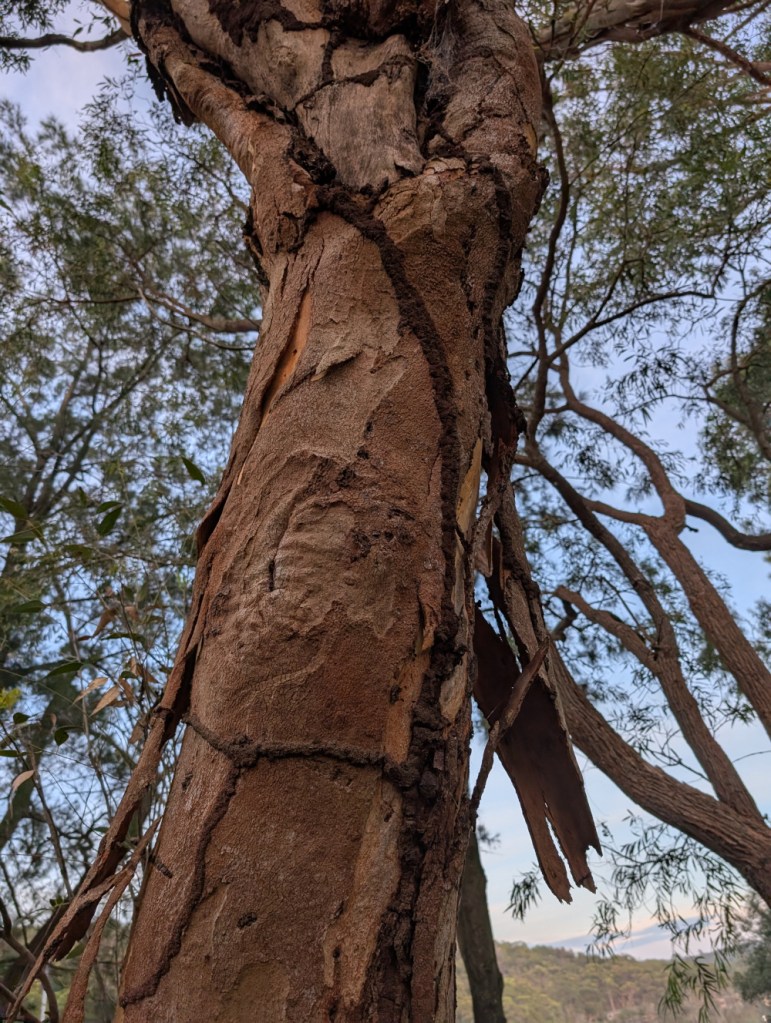
The termites in this part of Australia build their nests as large mud mounds, stuck high up in a tree:

Termite nests make a handy home for monitor lizards, kookaburras, kingfishers, and other creatures. In an earlier post, I showed pictures of a termite nest that had been adopted by kookaburras as a home for their young family: Baby kookaburras out of their nest.
In the next video, two young kookaburras attack the side of a termite nest, slowly digging a hole in the nest. They’re probably thinking ahead to the next breeding season, when such a home will come in useful:
In the video, you can hear the two kookaburras chattering, and other kookaburras giving the full laughing cackle in the background. There are also cicadas singing, and a butcherbird calls at one time too.
Common name: Laughing Kookaburra
Scientific name: Dacelo novaeguineae
Approximate length: 47 cm
Date spotted: 13 January 2025 (summer)
Location: Manly Dam near Sydney, New South Wales, Australia
Baby kookaburras out of nest
For the past month, I’ve been watching a termite nest that housed two Laughing Kookaburra chicks. The kookaburra parents had set up house in an old termite nest in a dead tree. The sound of the chicks crooning drew me to the tree on November 21st. The chicks were still very young, and it wasn’t possible to see them. But after waiting around a while, I did see the parents bringing food to the nest:
A month later, on December 20th, the chicks were right at the opening of the nest, peering out at the world. This photo shows one of the babies — you can see one eye clearly on the right, then the beak and white bib and the other eye on the left:

Here’s a view of the termite nest at the top of a dead tree. The nest projects from the top the right of the dead trunk, nicely protected by the branches of a living tree:
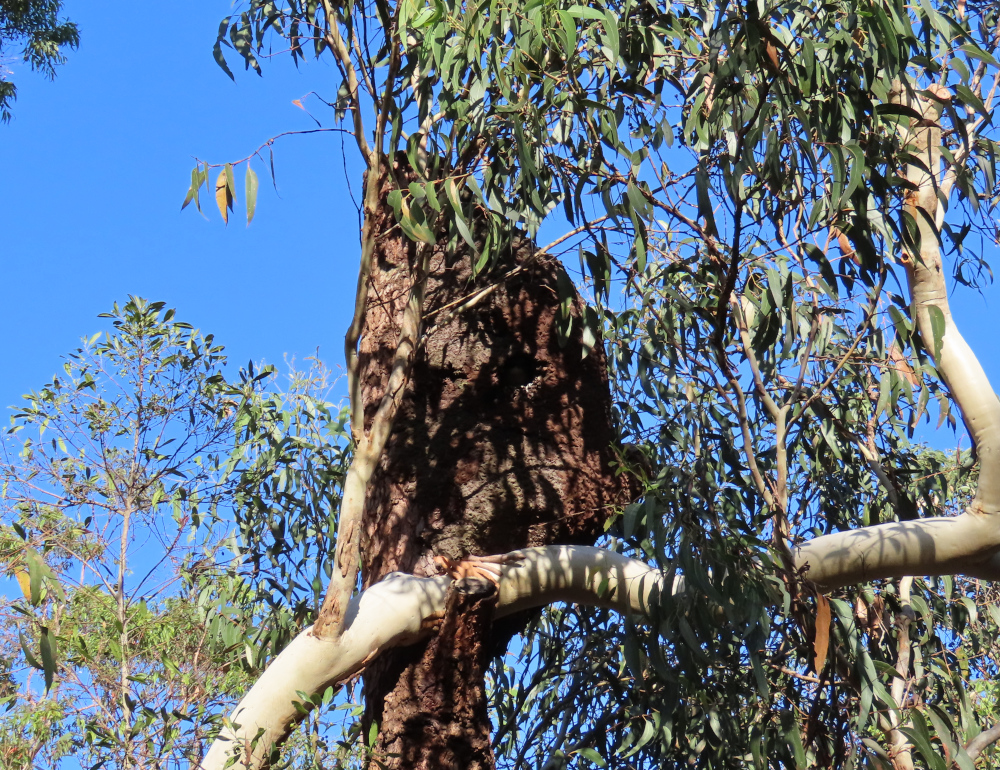
Here’s one of the parents with a morsel of food — a winged insect of some kind:

By my next visit, on December 23rd, the nest was empty. Both babies were out and about, calling and being fed by the adult birds.
One of the babies was on the ground when I got there, but soon managed to fly up onto a tree branch. The parents were nearby and attentive:
The youngsters are a bit smaller than the adults, and more fluffy. Their feathers aren’t yet fully developed, especially on the head and wings, and the tails are noticeably shorter.
The other youngster was on a nearby branch, also crooning:
This photo shows the youngster’s short tail:
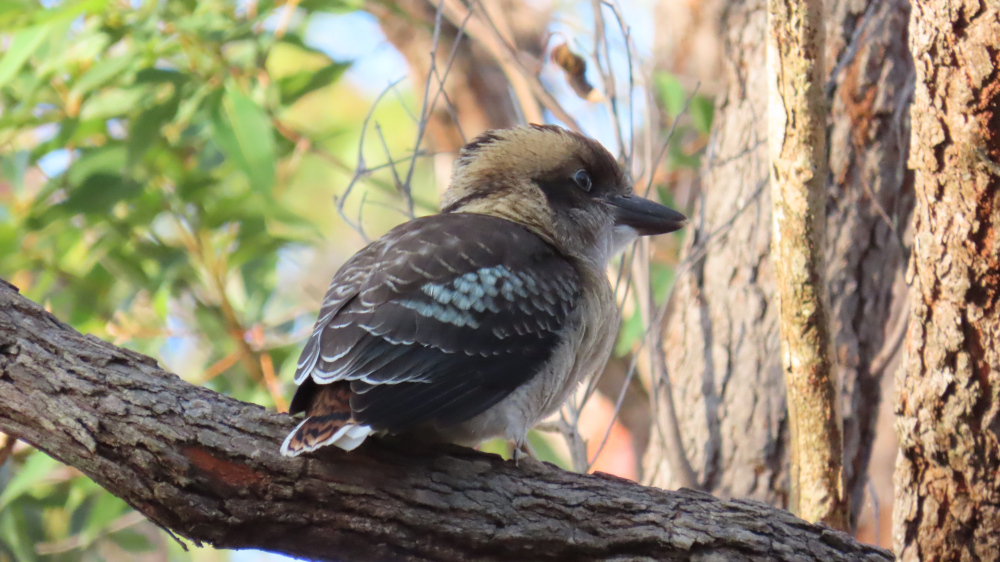
To close off, here’s the same youngster from another angle:
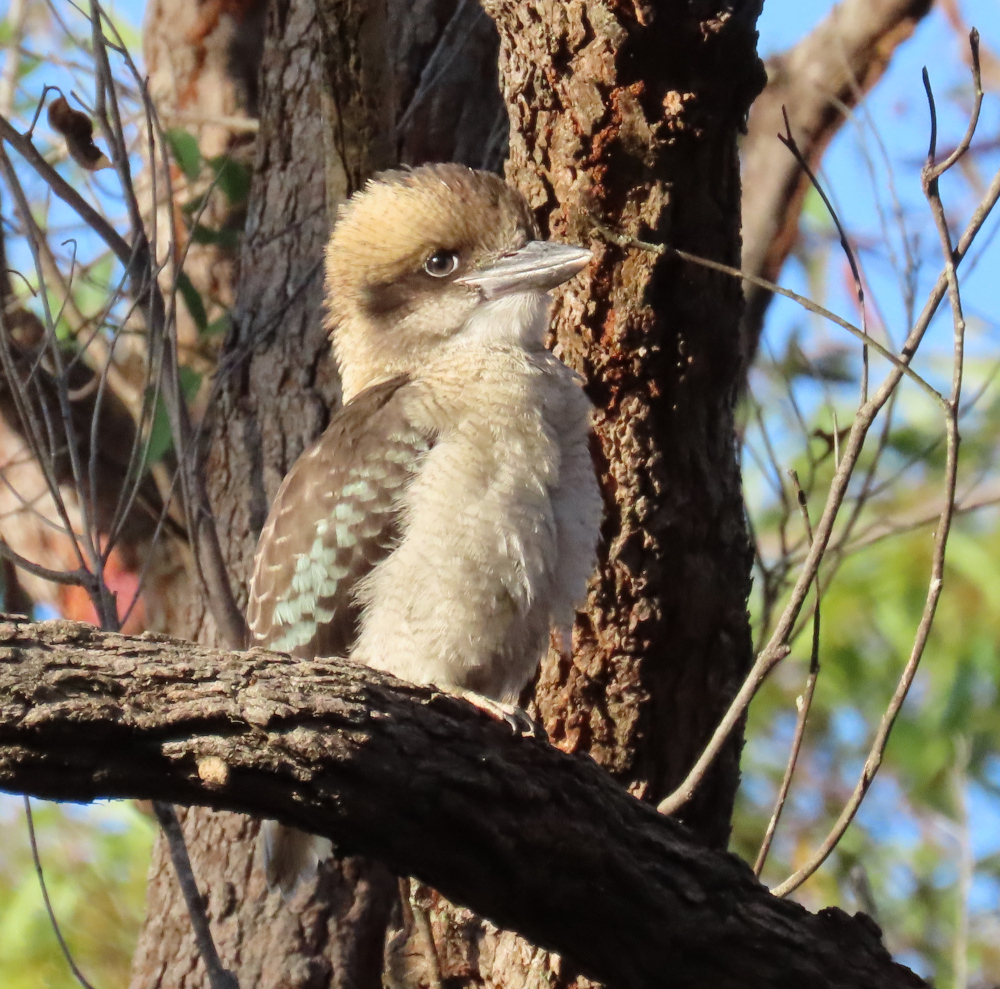
Common name: Laughing Kookaburra
Scientific name: Dacelo novaeguineae
Approximate length (adult): 47 cm
Date spotted: 21 November to 23 December 2024 (summer)
Location: Manly Dam near Sydney, New South Wales, Australia
Did the big scary lizard make the Mudlarks abandon their nest?
For a few weeks now, I’ve been watching a pair of Mudlarks building their nest. In fact, they’ve built two nests. The first one looked good and solid from my vantage point, far away and down at ground level. But a couple of days after they’d finished it, they abandoned it and started a new one higher up in the same tree.
Mudlarks, also called Magpie-larks or Peewees, build neat round nests that are basically bowls made of mud. This video shows a male Mudlark collecting mud and reeds at the water’s edge. When he has a good collection, he flies off towards the nest that he and his mate are constructing. As the bird flies, a couple of Kookaburras start cackling, and one of the Mudlarks gives its distinctive call: “pee-wee pee-wee pee-wee”.
Here’s the male Mudlark on mud collection duty:

The next video shows the first nest under construction. The bird prods and pushes mud into the walls of the nest, then sits flat and wiggles its tail end to shape the nest.
As well as building walls, nest construction also involves sitting on the nest and wiggling back and forth to get the shape right:

The nest was looking good, I thought. But several days later, a decision is made. The birds abandon their first attempt and start a new nest, higher up in the same tree:
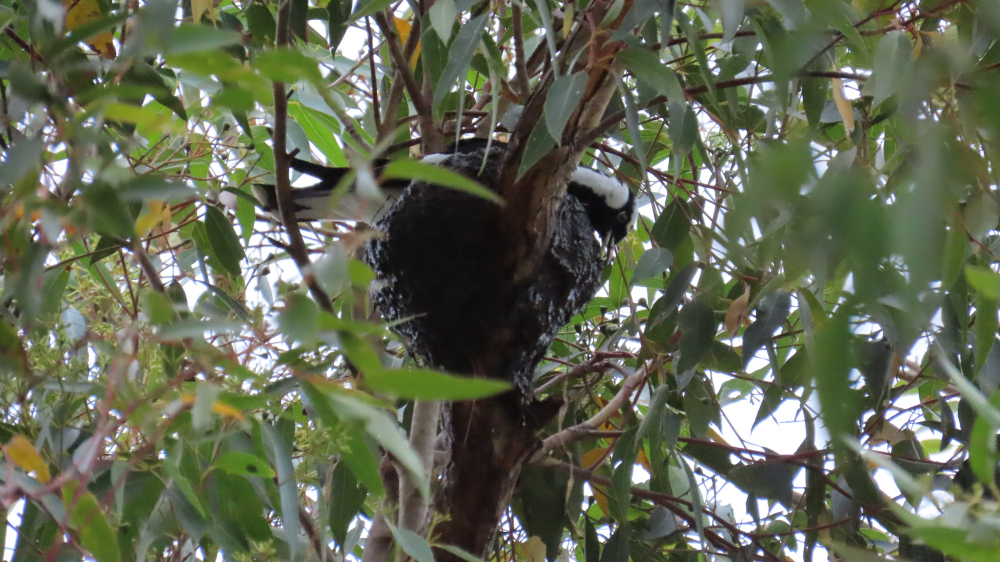
They’ve chosen a lovely spot, at the edge of Manly Dam. The next video shows one of the birds building the second nest. The second bird arrives with a beak-ful of mud, and takes over construction. The video then zooms out and in again to show the first nest on a lower branch, then zooms out further to show the dam and some of the neighbours (a Little Black Cormorant and a Great Egret).
Aside from the occasional noisy cockatoo, the neighbours are quiet for the most part — like this Great Egret:

And a few water dragons:

But the park does get quite busy over the weekend. Families hold picnics nearby, and children paddle in canoes. Perhaps the birds moved higher to avoid the weekend disturbance.
Perhaps the first nest didn’t meet quality assurance checks. Or perhaps the two parents-to-be spotted the large, scary intruder in the neighbourhood: a Lace Monitor lizard. I took this video of the lizard prowling around the tree where both nests are. Lace Monitors eat eggs and baby birds, and are very good at climbing trees. The Mudlarks’ second nest is higher in the tree and on thinner branches, which would make it much more difficult for the lizard to reach.
Lace Monitors are the second-largest lizards in Australia. They measure 1.5 to 2 metres long — longer than I am tall, and their hands are as big as mine! Here’s a close-up of the Lace Monitor on the move:
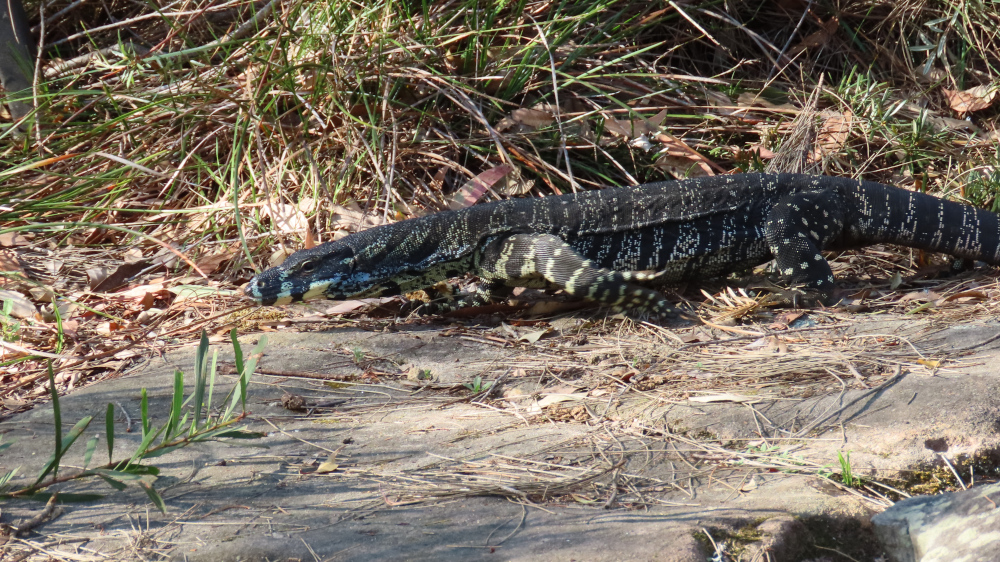
When I got too close with my camera, the lizard crouched down and went into stealth mode:

The Mudlarks are still sitting happily on their new nest. Here’s the male:

And here’s the female:
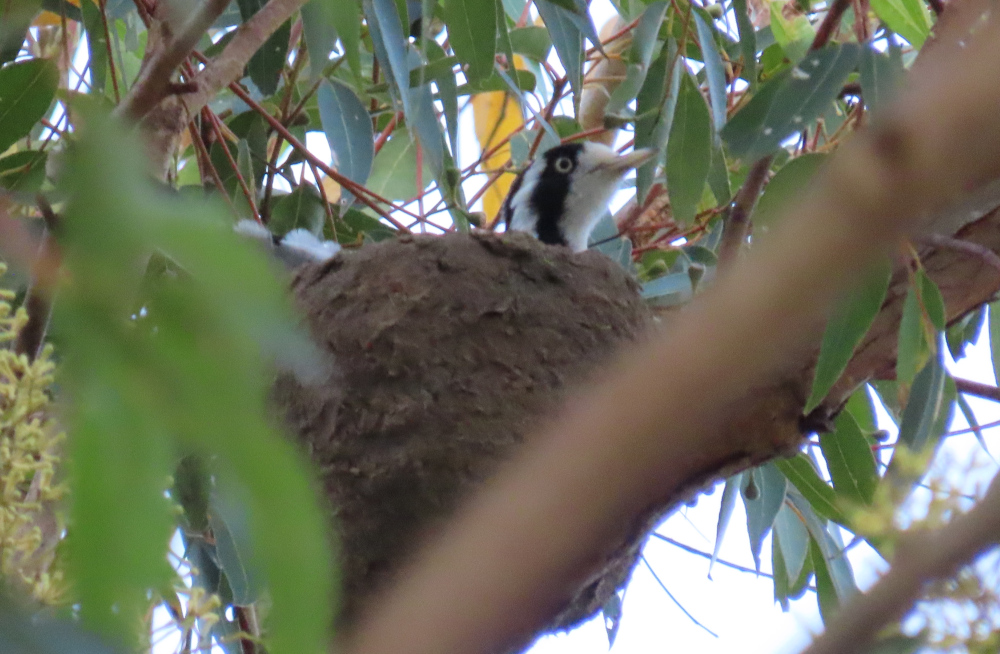
Good luck to them and their new family!
Common name: Magpie-lark, also called a Peewee or a Mudlark
Scientific name: Grallina cyanoleuca
Approximate length: 30 cm
Date spotted: August to September 2024 (summer)
Location: Manly Dam National Park, New South Wales, Australia
Magpie-lark nest with chicks
A couple of days ago, I spotted a Magpie-lark having a quick cicada snack. Today, back in the same area of Manly Dam, there was more activity in the Magpie-lark community. It turns out that the birds have a nest nearby, and the adults are busily feeding the chicks.
In this video, the chicks’ heads pop up when the adult arrives to feed them. When the adult leaves, the babies stretch the necks, begging for more.
As you can tell, the nest was quite far away from my vantage point, and my camera’s zooming powers are stretched to the utmost. Still, you can see what’s happening.
Here’s a still shot of the nest with an adult Magpie-lark peering down into it. The adult is a female, as it has a white throat. You can see the white underbelly of the bird towards the left, the black wings above, and then, on the right of the branch, the black-and-white head with the bird’s eye just above the rim of the nest:
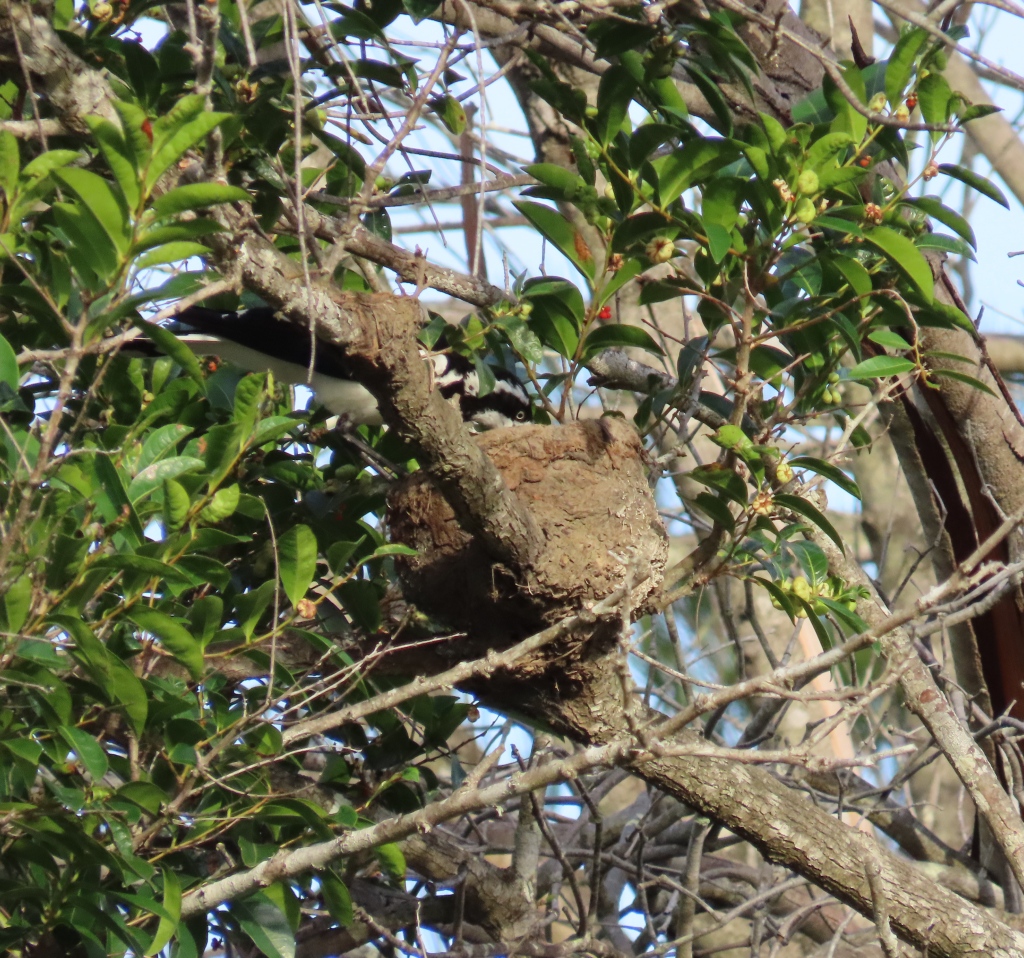
Gathering food and feeding babies is hard work. The adults often take a breather within sight of the nest, but out of sight of the babies, so that the babies don’t squawk for food. Here’s a male adult (black throat) at top right of the photo, with the nest near the bottom left:
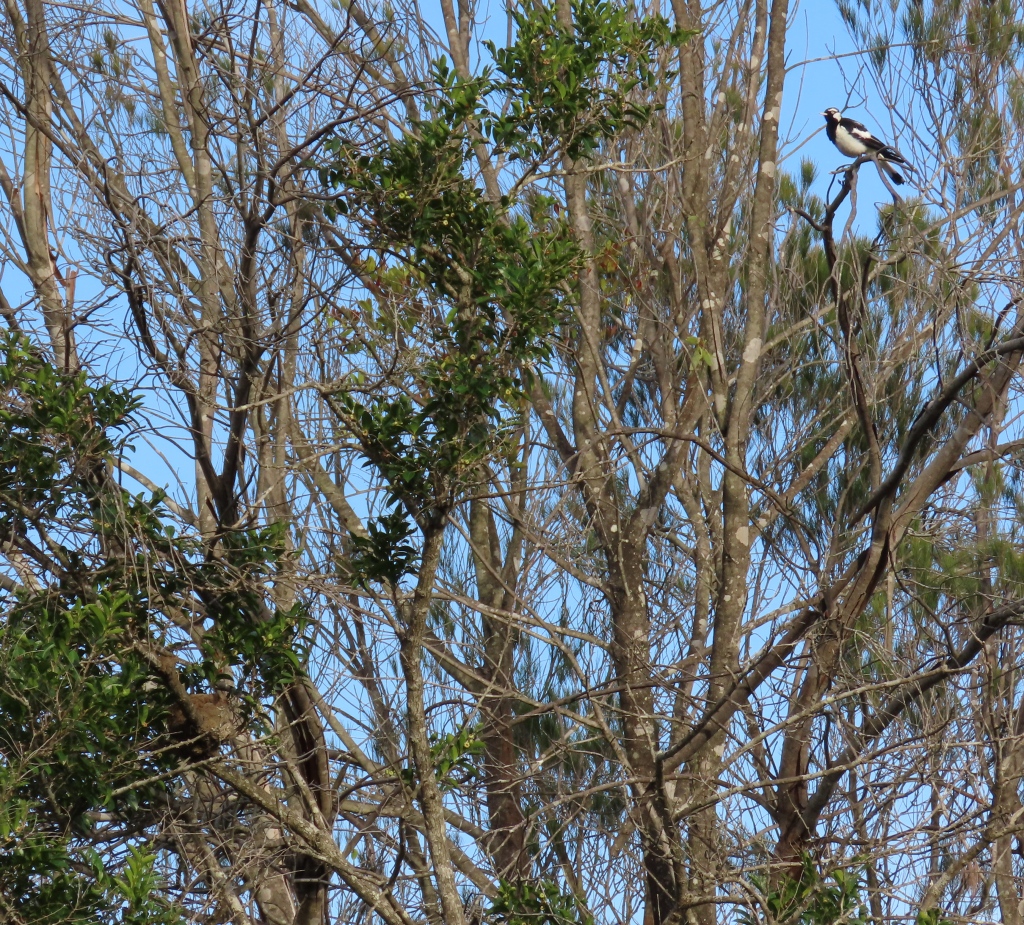
Here’s a closeup of the adult taking a breather:
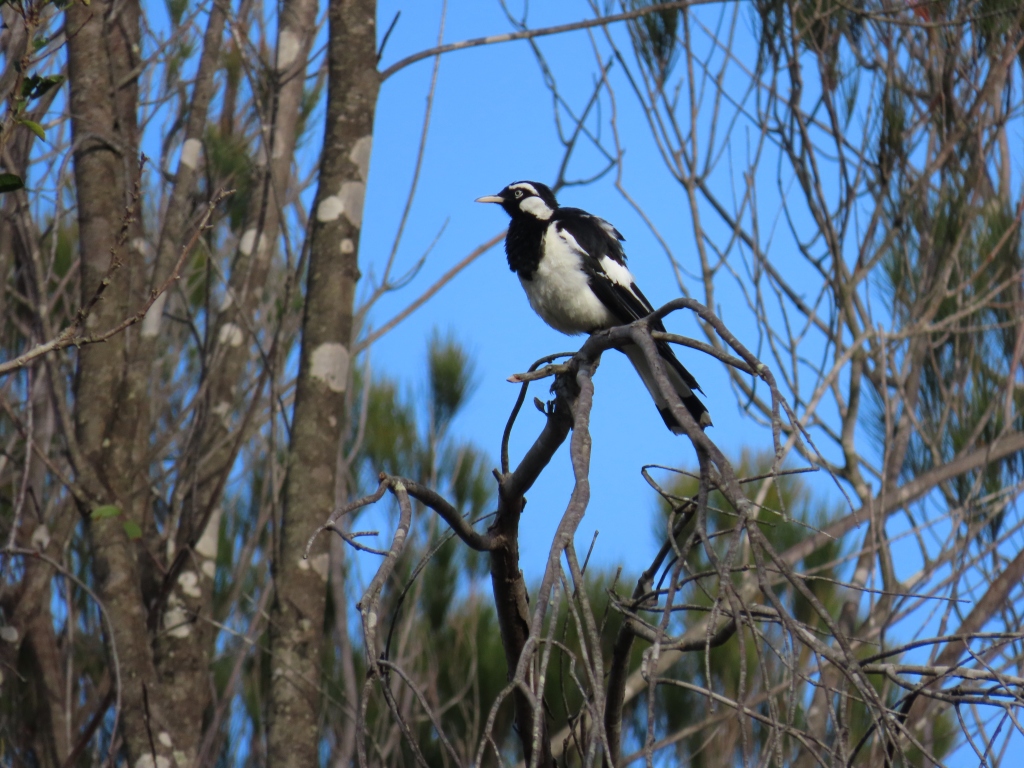
Common name: Magpie-lark, also called a Peewee or a Mudlark
Scientific name: Grallina cyanoleuca
Approximate length: 30 cm
Date spotted: 7 January 2024 (summer)
Location: Manly Dam National Park, New South Wales, Australia: 33°46’35.5″S 151°14’50.3″E
Red-browed Finch builds nest in lichen-covered tree
A little Red-browed Finch wrangles a long supple twig into its nest. The nest is in a lichen-covered tree, making a pretty scene with the red flashes on the bird against the green of the lichen.
The nest is barrel-shaped, bigger than I’d expect for such a small bird, with a small hole at one end:
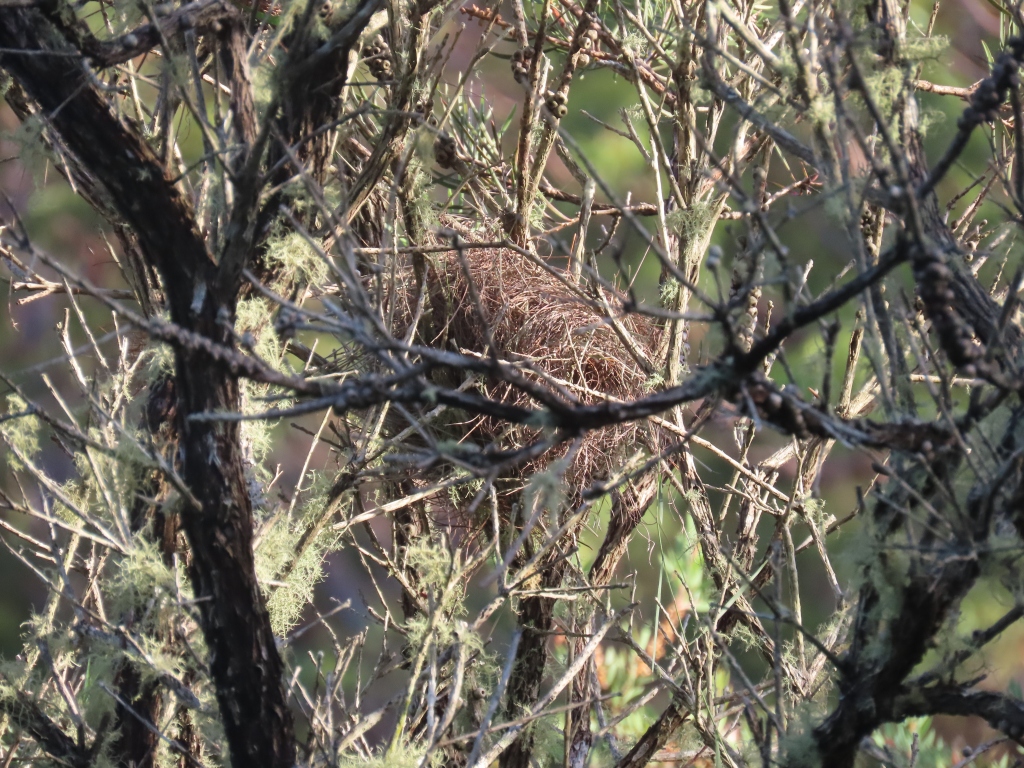
The tree is in a swampy area of Manly Dam. When the weather is wet and humid, the lichen flourishes, as now:
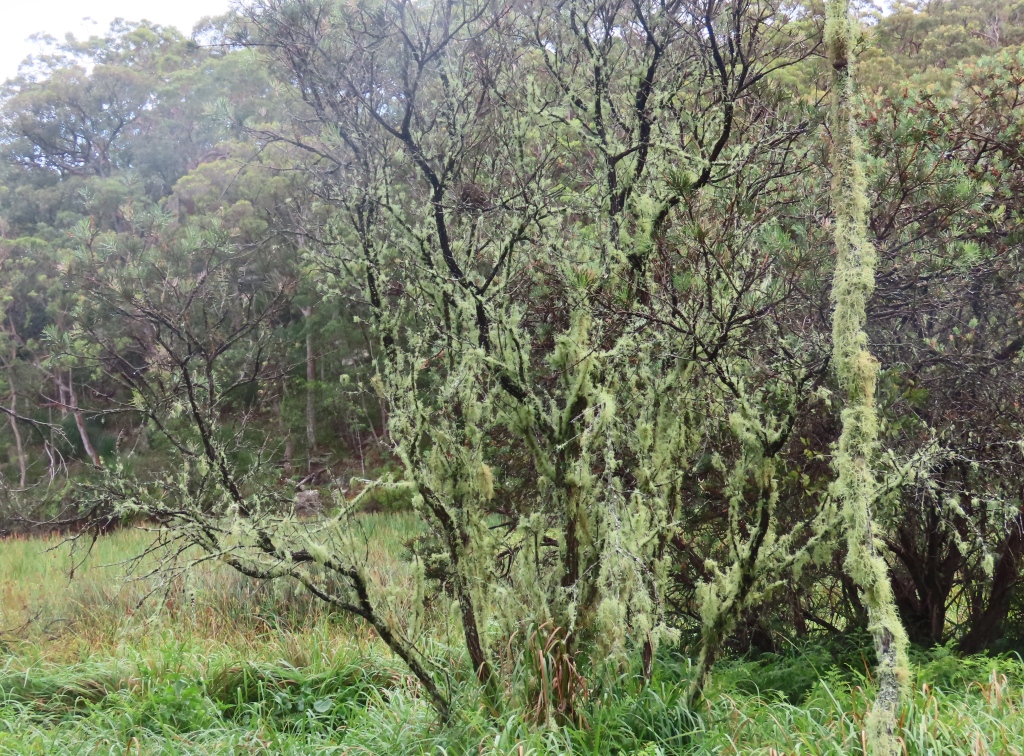
In the dry summer heat yet to come, the lichen will die away, but it always seems to come back.
Common name: Red-browed Finch
Scientific name: Neochmia temporalis
Approximate length: 12 cm
Date spotted: 22 December 2023 (summer)
Location: Manly Dam park, near Sydney: 33°46’23.1″S 151°14’35.9″E
Noisy Friarbird on nest at Coxs River
Off the beaten track for a day, I was delighted to see a Noisy Friarbird. Even more delightful was the fact that the bird was one of two taking turns to look after a nest:
The video shows one of the birds on the nest. It looks like there might be a youngster already hatched, because the bird seems to be passing something down into the nest (food?) and taking something else out (excrement?). At the end of the video, I panned out to show the lovely setting that the birds have chosen for their nest. It’s above Coxs River, with high trees and flowing water all round.
This is the first time I’ve seen a Noisy Friarbird. Indeed, it’s only the second friarbird that I’ve ever seen — the first was a Helmeted Friarbird up in North Queensland.
The nest is quite large and deep. It’s made of leaves, bark, and grass. Evidently the birds bind it together with spiderweb. Here’s a picture of one of the two birds sitting on the nest:
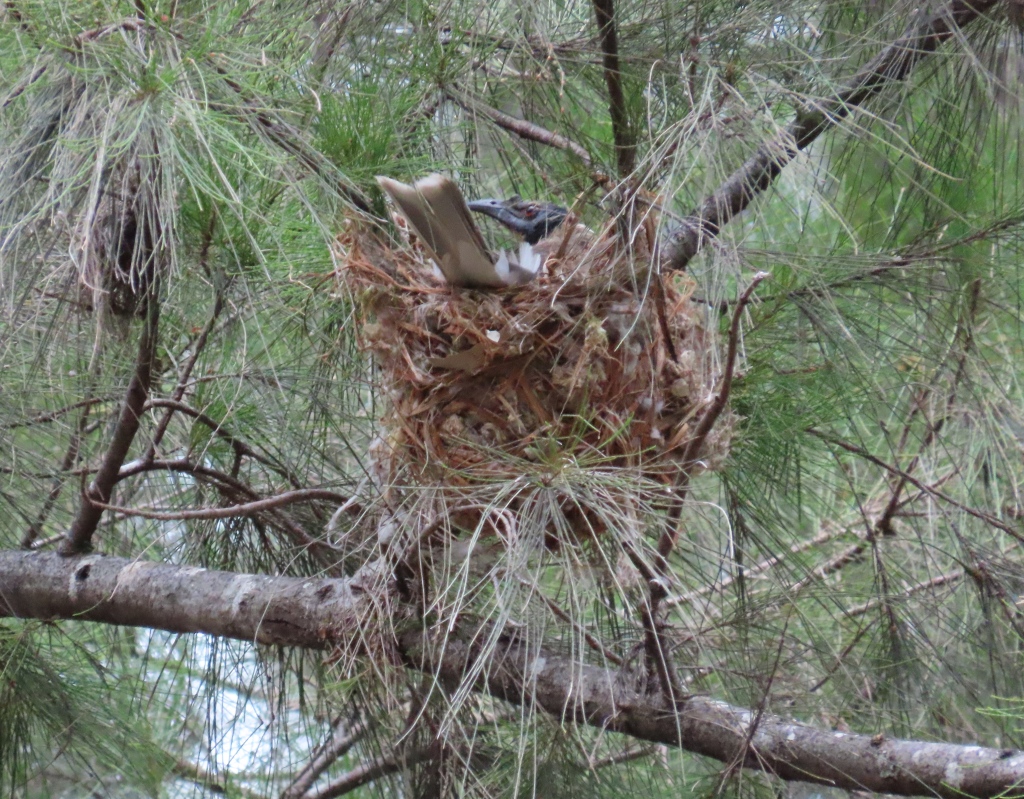
Noisy Friarbirds have a distinctive, slightly scary head: it’s bare of feathers, so that it looks a bit like a long black skull. Then there’s the large beak, with a knob on top. Not the prettiest of faces. The rest of the bird is quite pretty though, with creamy dappled white feathers below and soft browns and greys above, finished off with a white-tipped tail.
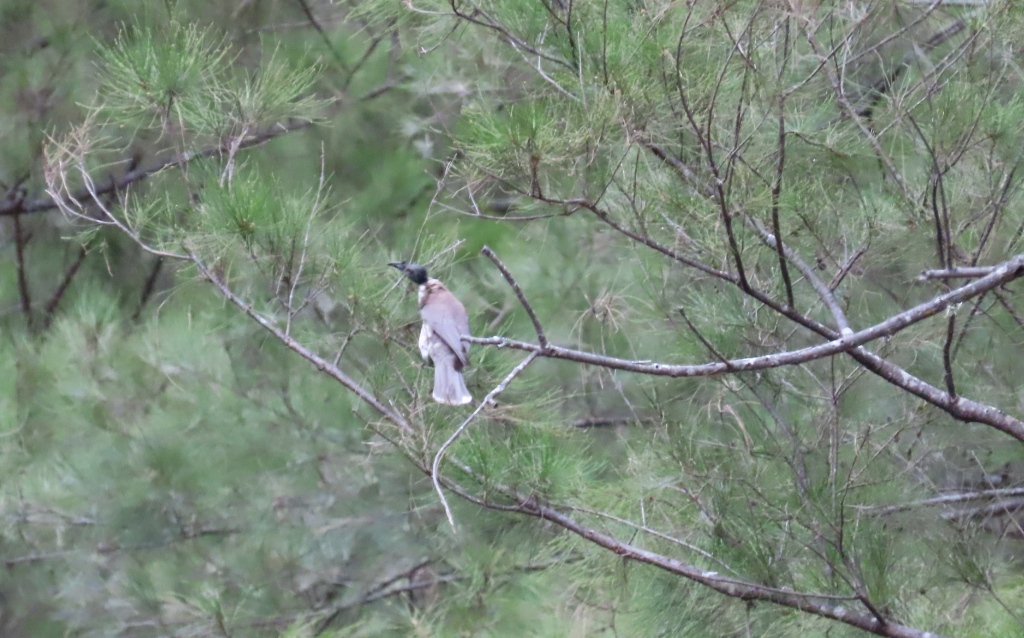
A few times, the birds would dive down steeply and fly horizontally just above the water. I think they were probably grabbing dragonflies and other insects as a tasty morsel:

This bird has something in its beak:

Common name: Noisy Friarbird
Scientific name: Philemon corniculatus
Approximate length: 30-35 cm
Date spotted: 23 December 2022 (summer)
Location: Coxs River Campground, Ganbenang, New South Wales, Australia: 33°44’35.1″S 150°10’45.1″E
Coxs River Campground is accessible only by four wheel drive. It’s a beautiful, restful spot, though it can get quite busy at times:

Channel-billed Cuckoo laying egg in Currawong nest
This little episode happened in my garden today. It was interesting and exciting to watch!
A cacophany of Noisy Miners and Currawongs drew me out into the garden to see what was up. High in a gum tree were two Channel-billed Cuckoos, being harassed as usual by the other birds. I only managed to get one of the cuckoos into my camera sights. Luckily, it turned out to be the female bird.
Here’s the Channel-billed Cuckoo on the right, with a little Noisy Miner by its side:
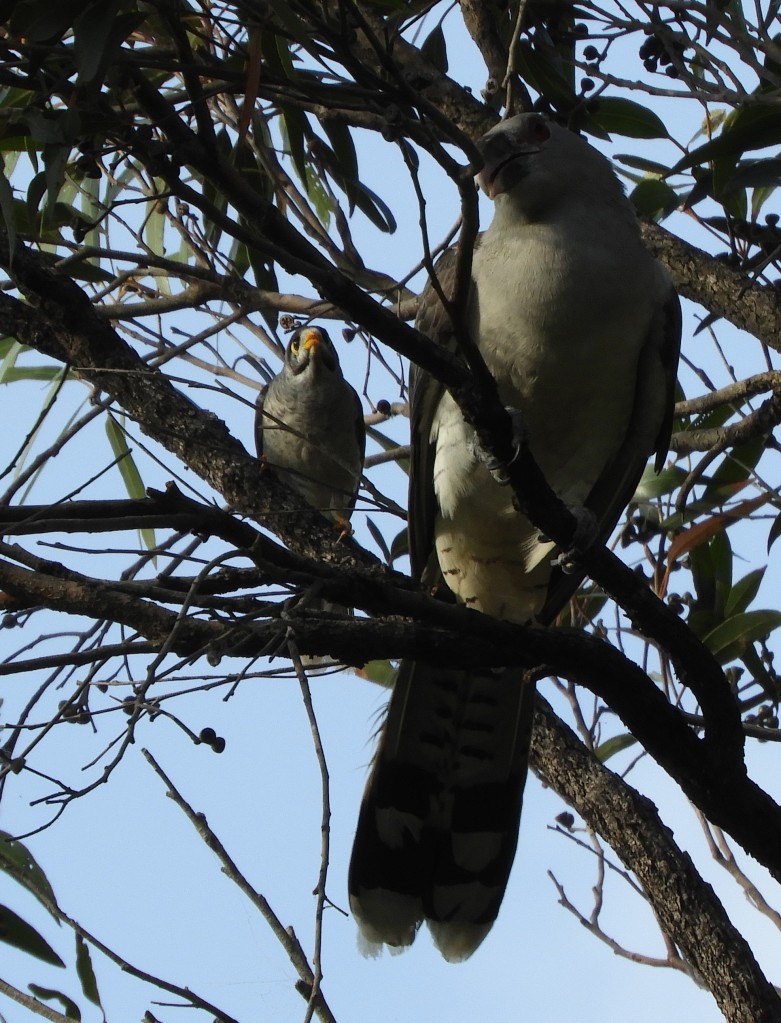
In this short video, you can hear the Noisy Miners peeping incessantly. The cuckoo emits a loud, harsh caw and cedes ground:
Next, the local Currawongs join the attack. The musical, bell-like tones are the Currawongs. The cuckoo flinches and utters its harsh croak. Then I noticed that there’s a Currawong nest just below where the cuckoo is sitting!
Like most cuckoos, Channel-billed Cuckoos are parasitic. They don’t build nests of their own. Instead, they look for a likely host (a Currawong does very nicely, thank you) and lay an egg in the chosen host’s nest. The Currawongs take over all parental duties, looking after the egg along with those of their own, then feeding the baby bird.
Channel-billed Cuckoo chicks don’t turf the other chicks out of the nest (many types of cuckoo chicks do) but they do eat a lot, and grow significantly bigger than the Currawong chicks.
Having decided that the neighbourhood is reasonably quiet and safe for a bit, the cuckoo eyes the nest and starts its approach:
Quick as a flash, it hops up into the nest and lays its egg:
Below is a still picture of the Currawong’s nest. I’ll keep an eye on it, in case I can spot the Currawong and cuckoo chicks when they arrive:

Channel-billed Cuckoo | Scythrops novaehollandiae | Approximate length: 58-65 cm
Noisy Miner, also called Australian Miner | Manorina melanocephala | Approximate length: 26 cm
Pied Currawong | Strepera graculina | Approximate length: 45 cm
Date spotted: 10 October 2021 (spring)
Location: Allambie Heights, New South Wales, Australia
Currawong snacks on brush-turkey’s scrapings
Spring is approaching, and male Australian Brush-turkeys are busily preparing their mounds in the hopes of attracting a female. This year there seem to be more brush-turkeys in my area than ever before. On the plus side, they do a great job of clearing the ground near their chosen location for a mound. On the minus side, the mound itself is a little unsightly. Unless you happen to be a brush-turkey, of course.
A canny currawong hung around close to this particular busy brush-turkey, snapping up the beetles and grubs that the brush-turkey’s scraping exposed:
The brush-turkey was scraping the leaves methodically and energetically in a single direction. His destination lay behind him. So I went round and found the large pile that he was creating. It was already over a metre high and three to four metres across.
A day later, I returned to the area and found the brush-turkey close to his mound:

Common name: Australian Brush-turkey
Scientific name: Alectura lathami
Approximate length: 60-70 cm
Date spotted: 25 August 2021 (winter)
Location: Manly Dam Park, New South Wales, Australia: 33°46’37.7″S 151°14’48.8″E








